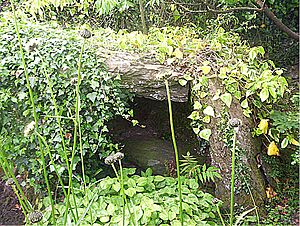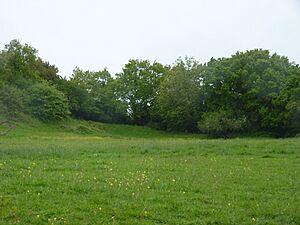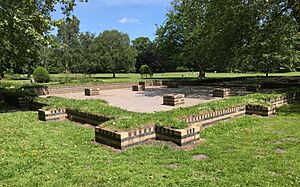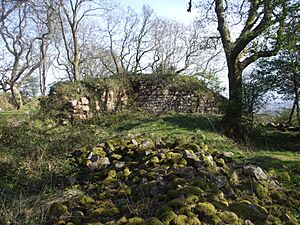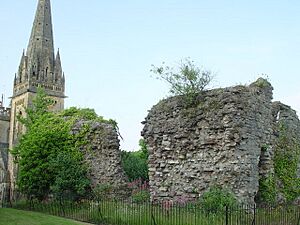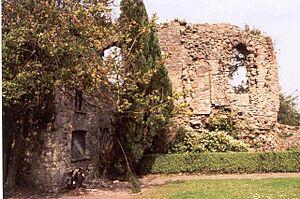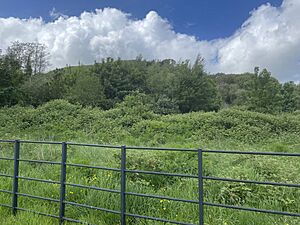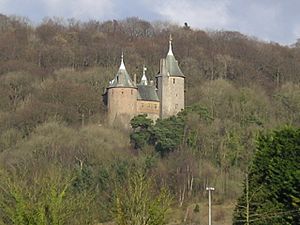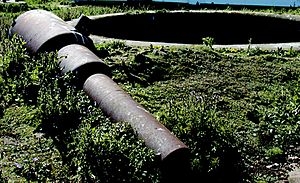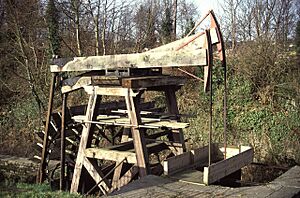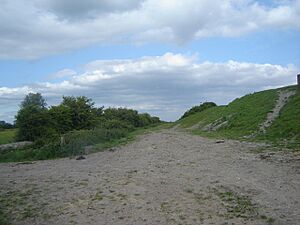List of scheduled monuments in Cardiff facts for kids
Cardiff is the capital and largest city in Wales. It's a really old city with a long history! All around Cardiff, there are 28 special places called scheduled monuments. These are important historical sites that are protected by law. They show us what life was like in Wales from the Stone Age (Neolithic period) all the way up to more recent times.
Cardiff has four hillforts, six castles, and six sites near the coast or ports. This shows how important Cardiff was for defending South Wales throughout history. Almost all these sites are in the historic area called Glamorgan. Only a tiny part of modern Cardiff used to be in a different area called Monmouthshire.
These special places are protected by an organization called Cadw. Cadw is a Welsh government agency that looks after historic sites. They work with other groups like RCAHMW and Glamorgan-Gwent Archaeological Trust to find and protect these amazing monuments.
Contents
Cardiff's Ancient Treasures
Cardiff is full of amazing historical sites! Let's explore some of these protected monuments, from ancient burial places to mighty castles.
Prehistoric Wonders
Long, long ago, before written history, people lived in Cardiff. We can still find traces of their lives today.
- Cae-yr-Arfau Burial Chamber
This is an ancient tomb from the Neolithic period, which was a very early part of the Stone Age. It has two tall stones holding up a huge flat stone. Imagine, this ancient tomb was once used to store coal! Now, it's a protected site in a garden.
This is a large hillfort from the Iron Age, which was about 2,000 to 3,000 years ago. It covers about 5 hectares (that's like 12 football fields!). The hillfort has big, wooded banks that were once defensive walls. Inside, there are even older ruins of a church and a castle. This site was even featured on the TV show Time Team in 2012!
Another Iron Age hillfort, this one is smaller but still an important reminder of how people lived and defended themselves long ago.
- Wenallt Camp
This is another hillfort located in Rhiwbina. These hillforts show that the area was an important place for communities in the Iron Age.
Roman Cardiff
The Romans arrived in Wales around 48 AD. They built forts and roads, and their influence can still be seen today.
Cardiff Castle is a famous landmark, but did you know it was built on top of an old Roman fort? The Romans built a fort here to control the area. Later, a medieval castle was built on the same spot, using some of the Roman foundations. It's a fantastic example of how history builds upon itself!
- Ely Roman Villa
This was a large Roman country house. Roman villas were often like fancy farms, where wealthy Romans lived and managed their land. Finding a villa here tells us about Roman life outside their military forts.
Early Medieval Times
After the Romans left, Wales entered a period known as the Early Medieval age.
- Cross in Llandaff Cathedral
Inside the beautiful Llandaff Cathedral, there is an ancient cross from the Early Medieval period. It's a piece of art and history that has survived for many centuries.
Medieval Castles and Churches
The Medieval period (roughly 1066 to 1500 AD) was a time of knights, castles, and grand cathedrals. Cardiff has many treasures from this era.
- Blackfriars Priory (Dominican), Bute Park
This site in Bute Park shows the outline of a former Dominican friary. Friaries were homes for groups of religious men called friars. This one was built by the Dominicans, also known as Blackfriars because of their black cloaks.
This castle is located on the border between Cardiff and Caerphilly. It's a medieval castle ruin that tells us about the conflicts and power struggles of the time.
- Llandaff Cathedral Bell Tower
The ruined medieval bell tower at Llandaff Cathedral is another important historical structure. It's a reminder of the grand architecture of the Middle Ages.
Near Llandaff Cathedral are the ruins of the Bishop's Palace. This was the home of the Bishop of Llandaff during the medieval period.
- Morganstown Castle Mound
This is a "motte," which is a type of castle mound. It's a raised earthwork that would have had a wooden tower on top, forming an early type of castle.
- Twmpath Castle
Another motte castle, Twmpath Castle in Rhiwbina is a reminder of the Norman conquest and the castles they built to control the land.
This is one of Cardiff's most famous castles! While it looks like a medieval castle, much of what we see today was actually rebuilt in the Victorian era. However, it sits on the foundations of a much older medieval castle. It's a fairytale castle that's definitely worth a visit!
Post-Medieval and Modern Sites
History didn't stop in the Middle Ages! Cardiff also has protected sites from more recent times, showing its role in industry and defense.
- Three Palmerstonian Gun Batteries, Flat Holm
Flat Holm is an island off the coast of Cardiff. These gun batteries were built in the Victorian era (around the 1860s) to defend the Bristol Channel from attacks. They are named after Prime Minister Lord Palmerston, who ordered many such defenses to be built around Britain.
- Melingriffith Water Pump
This historic water pump was part of the Melingriffith Tin Plate Works. It was used to pump water from the River Taff to power the works. It's a great example of Cardiff's industrial heritage.
- Relict Seawall on Rumney Great Wharf
This old seawall shows how people tried to protect the land from the sea in the past. It's a reminder of how the coastline has changed over time.
Images for kids
See also
- Listed buildings in Cardiff
- List of Cadw properties
- List of castles in Wales
- List of hill forts in Wales
- Historic houses in Wales
- List of monastic houses in Wales
- List of museums in Wales
- List of Roman villas in Wales


